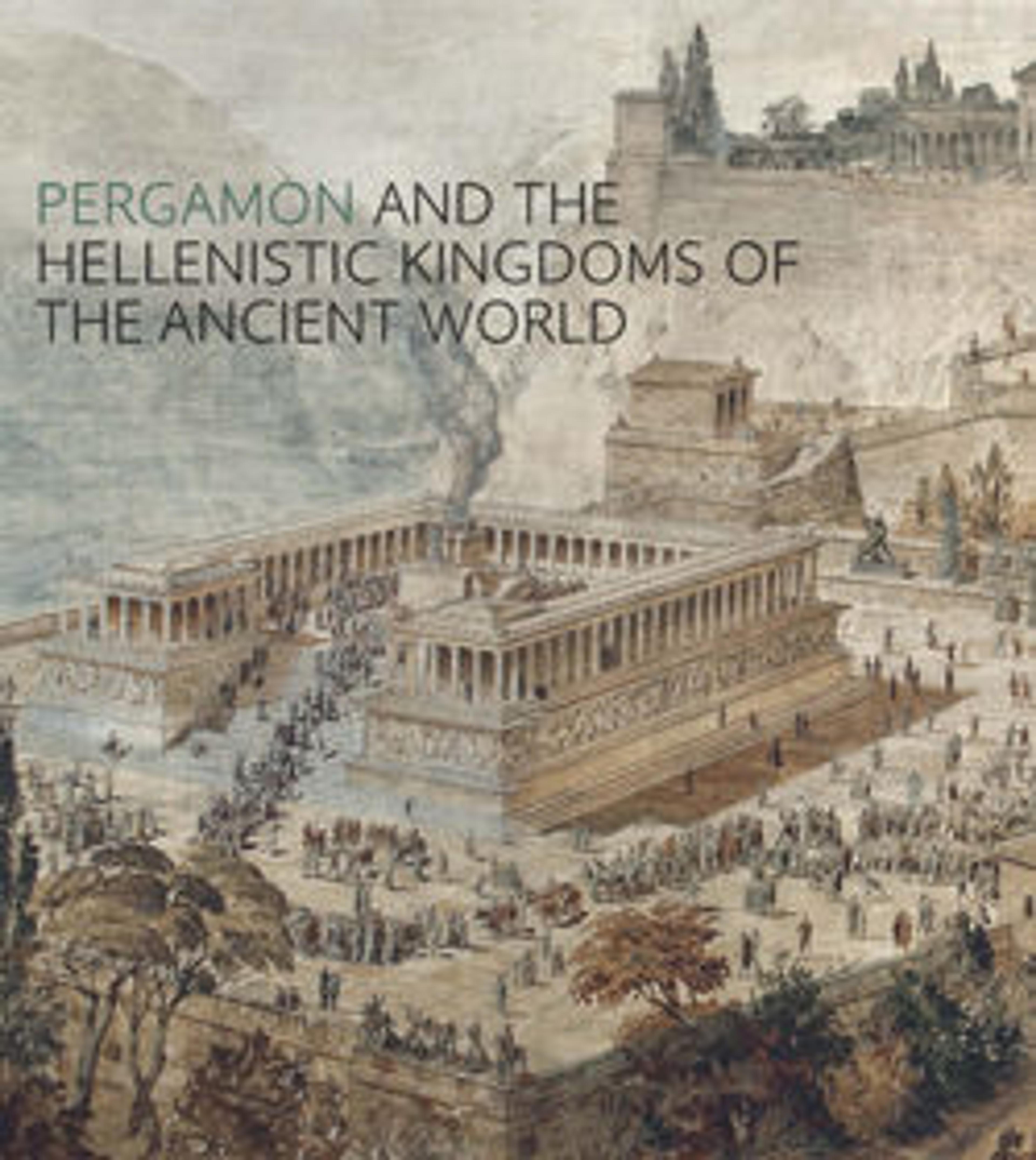Glass situla (bucket) with silver handles
Restituted
This artwork was restituted in September 2022. It is no longer in the museum’s collection.Translucent greenish.
Everted, angular rim, with thick vertical outer edge; slightly convex side tapering downwards; slightly domed bottom; two handle attachments, each pierced by two horizontal holes, project outward and upward from the edge of the rim on opposite sides of the bucket; two silver handles, each cut from a flat sheet into a semicircular arched strip, end in U-shaped round rods with decorative finials that are turned upward through the holes in the handle attachments.
The handle attachments are carved into rounded rectilinear blocks with a central upward finial with a raised outer surface, resembling a stylized palmette. On exterior, painted decoration extends from underside of rim to the bottom, comprising four main elements: at top, under rim, a continuous dog-tooth band in purplish red, with a thin line of light (Egyptian) blue below; on body, several irregular horizontal bands of small bud-like objects in shades of pinkish red, with details outlined in dark brown; on bottom, similar small objects, perhaps arranged in a rosette pattern; finally, two vertical stripes run down the sides of the bucket below the handle attachments, both are block-filled with purplish red paint, into which the lines of slender wavy tendrils have been incised freehand. Traces of gilding are visible on the stripes and elsewhere on the sides. The silver handles are fashioned into a stylized bud at the end of each rod.
Broken and repaired from numerous small fragments, with some losses and areas of fill; a few bubbles and many internal strain cracks; slight pitting and areas of whitish iridescent weathering; the silver handles are also broken and repaired.
The situla was used for cooling and serving wine at banquets. This one is made of almost colorless glass. It was cast and carved, and then bands of gilded and painted decoration were applied around the outside. The vessel is highly unusual in both shape and decoration, and few parallels in glass are known. It may, however, be compared with metal examples such as the bronze situla of the Prusias Find, which is displayed in the gallery for Greek art of the fourth century B.C.
Everted, angular rim, with thick vertical outer edge; slightly convex side tapering downwards; slightly domed bottom; two handle attachments, each pierced by two horizontal holes, project outward and upward from the edge of the rim on opposite sides of the bucket; two silver handles, each cut from a flat sheet into a semicircular arched strip, end in U-shaped round rods with decorative finials that are turned upward through the holes in the handle attachments.
The handle attachments are carved into rounded rectilinear blocks with a central upward finial with a raised outer surface, resembling a stylized palmette. On exterior, painted decoration extends from underside of rim to the bottom, comprising four main elements: at top, under rim, a continuous dog-tooth band in purplish red, with a thin line of light (Egyptian) blue below; on body, several irregular horizontal bands of small bud-like objects in shades of pinkish red, with details outlined in dark brown; on bottom, similar small objects, perhaps arranged in a rosette pattern; finally, two vertical stripes run down the sides of the bucket below the handle attachments, both are block-filled with purplish red paint, into which the lines of slender wavy tendrils have been incised freehand. Traces of gilding are visible on the stripes and elsewhere on the sides. The silver handles are fashioned into a stylized bud at the end of each rod.
Broken and repaired from numerous small fragments, with some losses and areas of fill; a few bubbles and many internal strain cracks; slight pitting and areas of whitish iridescent weathering; the silver handles are also broken and repaired.
The situla was used for cooling and serving wine at banquets. This one is made of almost colorless glass. It was cast and carved, and then bands of gilded and painted decoration were applied around the outside. The vessel is highly unusual in both shape and decoration, and few parallels in glass are known. It may, however, be compared with metal examples such as the bronze situla of the Prusias Find, which is displayed in the gallery for Greek art of the fourth century B.C.
Artwork Details
- Title: Glass situla (bucket) with silver handles
- Period: Late Classical or Early Hellenistic
- Date: late 4th–early 3rd century BCE
- Culture: Greek
- Medium: Glass with silver handles; cast
- Dimensions: 10 1/2 x 8 x 6 3/4in. (26.7 x 20.3 x 17.1cm)
- Classification: Glass
- Credit Line: Purchase, The Bernard and Audrey Aronson Charitable Trust Gift, in memory of her beloved husband, Bernard Aronson, 2000
- Curatorial Department: Greek and Roman Art
More Artwork
Research Resources
The Met provides unparalleled resources for research and welcomes an international community of students and scholars. The Met's Open Access API is where creators and researchers can connect to the The Met collection. Open Access data and public domain images are available for unrestricted commercial and noncommercial use without permission or fee.
To request images under copyright and other restrictions, please use this Image Request form.
Feedback
We continue to research and examine historical and cultural context for objects in The Met collection. If you have comments or questions about this object record, please complete and submit this form. The Museum looks forward to receiving your comments.
